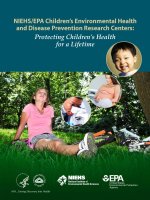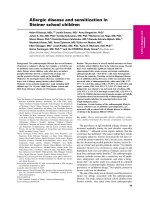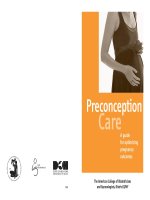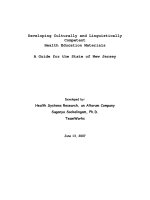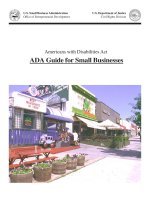Infectious Disease Control Guide for School Staff ppt
Bạn đang xem bản rút gọn của tài liệu. Xem và tải ngay bản đầy đủ của tài liệu tại đây (954.46 KB, 192 trang )
Dr. Terry Bergeson
State Superintendent of
Public Instruction
April 2004
State of Washington
Office of Superintendent of Public Instruction
Department of Health
Infectious Disease
Control Guide for
School Staff
Office of Superintendent of Public Instruction
Old Capitol Building
P.O. Box 47200
Olympia, WA 98504-7200
For more information about the contents
of this document, please contact:
Gayle Thronson, OSPI
E-mail:
Phone: 360.725 6040
To order more copies of this document,
please call 1-888-59-LEARN (I-888-595-3276)
or visit our Web site at
Please refer to the document number below for quicker service:
04-0014
This document is available online at:
This material is available in alternative format upon request.
Contact the Resource Center at (888) 595-3276, TTY (360) 664-3631.
Infectious Disease Control Guide for School Staff
Dr. Terry Bergeson
State Superintendent of Public Instruction
Marty S. Daybell
Deputy Superintendent
Administration and Operations
Chief Information Officer
Marcia L. Riggers
Assistant Superintendent
Student Support and Operations
Martin Mueller
Director
Learning and Teaching Support
Gayle Thronson
Health Services Program Supervisor
Learning and Teaching Support
Revised April 2004
Infectious Disease Control Guide i April 2004
for School Staff
Acknowledgements
The following agencies and organizations provided comments and revised text for the
2004 revision of the Infectious Disease Control Guide for School Staff:
1. Washington State Department of Health:
Community and Family Health Division
Maternal and Child Health
Infectious Disease and Reproductive Health
Epidemiology, Health Statistics, and Public Health Laboratories Division
Communicable Disease Epidemiology
2. Washington State Department of Labor and Industries
3. Washington State School Nurse Corps Program
4. School Nurse Organization of Washington
5. Thurston County Public Health and Social Services Department
6. American Academy of Pediatrics, Washington Chapter
7. Washington State School Directors' Association
8. Office of the Attorney General
9. Editors-in-Chief:
Lonnie Peterson, Department of Health, Maternal and Child Health
Donna Vincent, Office of Superintendent of Public Instruction
Gratitude is expressed to the school nurses, local health jurisdictions, state Department
of Health staff members, licensed health care providers, and others who greatly
assisted in the preparation and review of this material.
Infectious Disease Control Guide ii April 2004
for School Staff
Table of Contents Page
Acknowledgements…………………………………………………………………… i
Appendices……………………………………………………………………………… v
Acronyms………………………………………………………………………………. vii
Introduction……………………………………………………………………………. 1
Exclusion from School………………………………………………………………… 3
General Considerations………………………………………………………………. 5
Common Indicators of Infectious Diseases in Children…………………………… 6
Acquired Immunodeficiency Syndrome (AIDS)…………………………………… 9
Athlete’s Foot (Tinea Pedis)………………………………………………………… 12
Bites…………………………………………………………………………………… 14
Animal…………………………………………………………………………… 14
Human…………………………………………………………………………… 16
Chickenpox (Varicella)………………………………………………………………… 18
Common Cold………………………………………………………………………… 21
Conjunctivitis (Pink Eye)……………………………………………………………… 23
Cytomegalovirus Infection (CMV)………………………………………………….… 25
Diarrhea……………………………………………………………………………… 27
Diphtheria………………………………………………………………………………. 29
Fifth Disease (Erythema Infectiosum)……………………………………………… 31
Foodborne Disease……………………………………………………………………. 33
Hand, Foot, and Mouth Disease (HFMD)…………………………………………… 36
Hepatitis………………………………………………………………………………… 38
Hepatitis A, Viral (HAV)……………………………………………………… 38
Hepatitis B, Viral (HBV)……………………………………………………… 41
Hepatitis C, Viral (HCV)……………………………………………………… 45
Infectious Disease Control Guide iii April 2004
for School Staff
Table of Contents (cont.)
Page
Herpes Simplex Virus, Oral Area (Cold Sores)…………………………………… 48
Herpes Zoster (Shingles)……………………………………………………………… 51
Impetigo…………………………………………………………………………………. 53
Infectious Mononucleosis (Mono)……………………………………………………. 55
Influenza………………………………………………………………………………… 57
Lice (Pediculosis)………………………………………………………………………. 59
Body Lice (Pediculosis Humanus Corporis)…………………………………. 59
Crab Lice (Pediculosis Humanus Pubis)…………………………………… 60
Head Lice (Pediculosis Humanus Capitus)………………………………… 61
Measles…………………………………………………………………………………. 66
Meningitis……………………………………………………………………………… 69
Mosquito-borne Illness………………………………………………………………… 72
Mumps………………………………………………………………………………… 74
Norovirus (Norwalk-like)………………………………………………………………. 76
Pertussis (Whooping Cough)…………………………………………………………. 78
Pinworms……………………………………………………………………………… 81
Poliomyelitis (Polio)……………………………………………………………………. 83
Ringworm (Tinea)……………………………………………………………………… 85
Rubella (Three-day Measles)………………………………………………………… 87
Scabies………………………………………………………………………………… 89
Sexually Transmitted Disease (STD)……………………………………………… 92
Chlamydia……………………………………………………………………… 93
Gonorrhea (Clap, Strain, Dose)………………………………………………. 95
Herpes Simplex Virus, Genital Area………………………………………… 97
Non-Gonococcal Urethritis (NGU)……………………………………………. 99
Syphilis………………………………………………………………………… 101
Vaginitis………………………………………………………………………… 103
Infectious Disease Control Guide iv April 2004
for School Staff
Table of Contents (cont.) Page
Smallpox………………………………………………………………………………… 105
Streptococcal Sore Throat and Scarlet Fever………………………………………. 107
Tetanus (Lockjaw)…………………………………………………………………… 110
Tuberculosis (TB)……………………………………………………………………… 112
Warts (Verrucae)………………………………………………………………………. 115
Index…………………………………………………………………………………… 181
Infectious Disease Control Guide v April 2004
for School Staff
Appendix I: Immunization Law RCW 28A.210.060-170…………………… 116
Appendix II: RCW 28A.210.010 Contagious Diseases, Limiting Contact—
Rules and Regulations…………………………………………… 118
Appendix III: Chapter 246-110 WAC Contagious Disease—School Districts
and Day Care Centers
WAC 246-110-001 Purpose
WAC 246-110-010 Definitions
WAC 246-110-020 Control of Communicable (Contagious)
Disease
WAC 246-101-415 Responsibilities of Child Day Care
Facilities
WAC 243-101-420 Responsibilities of Schools.……………… 120
Appendix IV: Chapter 246-100 WAC Communicable and Certain Other
Diseases
WAC 246-100-006 Purpose
WAC 246-100-011 Definitions
WAC 246-100-021 Responsibilities and Duties—Health Care
Providers……………………………………………………………
125
Appendix V: Chapter 246-101 WAC Notifiable Conditions
WAC 246-101-101 Notifiable Conditions and the Health Care
Provider
WAC 246-101-105 Duties of the Health Care Provider
WAC 246-101-110 Means of Notification
WAC 246-101-115 Content of Notification
WAC 246-101-120 Handling of Case Reports and Medical
Information…………………………………………………………. 133
Appendix VI: Washington State School Directors’ Associations, Policy
3414—Infectious Disease……………………………………… 143
Infectious Disease Control Guide vi April 2004
for School Staff
Appendix VII: Chapter 246-366 WAC Primary and Secondary Schools……
145
Appendix VIII: Guidelines for Handling Body Fluids in Schools………………. 148
Appendix IX: Guidelines for the Placement of Children and Adolescents
Infected with the Human Immunodeficiency Virus (HIV)……… 158
Appendix X: RCW 70.24.110 Minors—Treatment, Consent, Liability for
Payment for Care…………………………………………………. 163
Appendix XI: RCW 28A.230.020 Common School Curriculum—
Fundamentals in Conduct………………………………………
165
Appendix XII: Local Health Jurisdictions……………………………………… 167
Appendix XIII: Resources………………………………………………………… 172
Appendix XIV: Sample Local School District Lice Policies
1. Permissive Nit Policy (Spokane School District)
2. No Nit Policy (Davenport School District)………………. 178
Infectious Disease Control Guide vii April 2004
for School Staff
Acronyms
AIDS Acquired Immunodeficiency Syndrome
CDC Centers for Disease Control and Prevention
CMV Cytomegalovirus Infection
DOH Washington State Department of Health
DT Diphtheria/Tetanus
DTaP Diphtheria/Tetanus/acellular Pertussis vaccine
DTP Diphtheria/Tetanus/Pertussis vaccine
HAV Hepatitis A Virus
HBIG Hepatitis B Immune Globulin
HBV Hepatitis B Virus
HCV Hepatitis C Virus
HIV Human Immunodeficiency Virus
HSV Herpes Simplex Virus
IDRH Infectious Disease and Reproductive Health
MMR Measles, Mumps, and Rubella vaccine
NGU Non-Gonococcal Urethritis
OSPI Office of Superintendent of Public Instruction
PPE Personal Protective Equipment
RCW Revised Code of Washington
STD Sexually Transmitted Disease
TB Tuberculosis
Td Tetanus/Diphtheria
VZIG Varicella-Zoster Immune Globulin
WAC Washington Administrative Code
Infectious Disease Control Guide 1 April 2004
for School Staff
Introduction
This material is provided to schools in the state of Washington to assist district staff
members in their efforts to preserve and protect the health of both students and
employees. Infectious diseases are very common in the school-age child. Because
several of the diseases addressed in this manual are vaccine-preventable, it is expected
that their incidence in the state will be reduced with the continued implementation of the
immunization law (RCW 28A.210.060-170, see Appendix I). School districts should
always refer to the most updated version of the specific law or regulation.
The following pages contain guidelines for the control and reporting of diseases in the
school-age population in the state of Washington. Schools are urged to consult with
their local health jurisdictions for specific measures to be used in handling individual
cases or outbreaks of disease. A number of diseases, although contagious, are not
covered in this guide since they are not often seen in school or in people of school age.
We have attempted to include information on the effects of childhood diseases on
adults in the school setting when the effects are unusual or particularly serious,
such as in chickenpox, cytomegalovirus, Fifth disease, measles, mumps, and
rubella.
RCW 28A.210.010 Contagious Diseases, limiting contact—Rules and regulations,
requires the State Board of Health, in consultation with the Superintendent of Public
Instruction, to “adopt rules and regulations regarding the presence of persons on or
about any school premises who have, or who have been exposed to, contagious
diseases deemed by the state board of health as dangerous to the public health.” (See
Appendix II.)
Chapter 246-110 WAC Contagious Disease—School District and Day Care Centers
was adopted for the purpose of governing the presence on or about any school or child
care center premises of susceptible persons who have, or have been exposed to, an
infectious disease. The law intends also that appropriate recommendation be made to
the parent when medical treatment is necessary, and that parents be guided to an
appropriate source of community sponsored medical care and/or their primary licensed
health care provider. Additionally, WAC 246-110-010 defines school as “each building,
facility, and location at or within which any or all portions of a preschool, kindergarten,
and grades one through twelve program of education and related activities are
conducted for two or more children by or in behalf of any public school district and by or
in behalf of any private school or private institution subject to approval by the state
board of education.” (See Appendix III.)
Infectious Disease Control Guide 2 April 2004
for School Staff
Another WAC, 246-101-420 Responsibilities of schools, establishes some steps
required of local school districts. (See Appendix III.) The following are the requirements
listed in this WAC:
1. Notify your local health jurisdiction of disease that may be associated with the
school.
2. Cooperate in monitoring influenza.
3. Consult with a licensed health care provider or your local health jurisdiction for
information regarding infectious disease, when necessary.
4. Cooperate in investigations.
Confidentiality of medical information is also addressed in WAC 246-101-420. School
staff with knowledge of a person diagnosed with a notifiable condition may only release
that information to others who are responsible for protecting the health of the public
through control of disease. Additionally, schools are required to implement policies and
procedures to maintain confidentiality of medical information possessed by the school.
Child care programs may refer to WAC 246-101-415 Responsibilities of child day care
facilities for similar requirements. (See Appendix III.)
It is clear that some diseases are “nuisance” diseases and are not considered
particularly dangerous to the community’s health. Some examples of nuisance diseases
are ringworm and infestation with lice or scabies. While these conditions may not have
high priority with local health jurisdictions and are not a significant threat to health, they
do cause considerable anguish and disruption to schools. Therefore, close cooperation
and consultation between school district administrators and local health jurisdictions is
essential for effective control of “nuisance” diseases in schools.
Infectious Disease Control Guide 3 April 2004
for School Staff
Exclusion from School
The local health officer is the primary resource in the identification and control of
infectious disease in the community, including child care centers and schools. School
staff knowing of a case or suspected case of a notifiable disease such as contained in
Chapter 246-110 WAC (see Appendix III), shall report the name and other identifying
information to the principal or school nurse. The school is required in WAC 246-101-420
(see Appendix III) to notify their local health jurisdiction. Additionally, both Chapter 246-
100 WAC Communicable and certain other diseases and Chapter 246-101 WAC
Notifiable conditions (see Appendices IV and V), define “health care provider” as “any
person having direct or supervisory responsibility for the delivery of care who is: a)
Licensed or certified in this state under Title 18 RCW…” As health care providers
licensed under Title 18 RCW, school nurses (registered nurses) shall follow the
requirements of the following WACs (see Appendix V):
• WAC 246-101-101 Notifiable conditions and the health care provider.
• WAC 246-101-105 Duties of the health care provider.
• WAC 246-101-110 Means of notification.
• WAC 246-101-115 Content of notification.
• WAC 246-101-120 Handling of case reports and medical information.
Local health officers may require reporting of additional diseases and conditions within
their respective jurisdictions.
The local health officer shall take whatever action he/she deems necessary to control or
eliminate the spread of the disease. There are several options available to the local
health officer:
1. Close the affected school(s).
2. Close other schools in the local health officer’s jurisdiction.
3. Cause the cessation of selected school activities or functions.
4. Exclude any students, staff, and volunteers who are infected with or deemed
susceptible to the disease (WAC 246-110-020, see Appendix III).
The local health officer is also required to discuss the ramifications of his/her actions
with the superintendent of the school district prior to taking action and provide the board
of directors and superintendent with a written order directing them to take action. See
WAC 246-110-020, Appendix III, for additional requirements.
It is recommended that each school district prepare and adopt, in advance, a policy
addressing infectious disease so that, when necessary, appropriate action may be
taken and parent/guardian is notified without delay. The Washington State School
Directors' Association (WSSDA) offers model policies and procedures for local school
Infectious Disease Control Guide 4 April 2004
for School Staff
districts. Appendix VI is WSSDA’s model district policy and procedures, Policy No.
3414—Infectious Diseases. Contact WSSDA regarding other health related sample
policies. See Resources, Appendix XIII, for contact information.
For temporary exclusion of inadequately immunized (susceptible) students during a
disease outbreak, refer to the Immunization Manual for Schools, Preschools and Child
Care Facilities, effective spring 2002. See Resources, Appendix XIII, for source.
For information and recommendations on implementation of the Washington Industrial
Safety and Health Act, Chapter 296-62-08001, Bloodborne Pathogens, consult the
Office of Superintendent of Public Instruction publication Guidelines for Implementation
of Hepatitis B and HIV School Employee Trainings. See Resources, Appendix XIII, for
source.
Infectious Disease Control Guide 5 April 2004
for School Staff
General Considerations
Exposure to a variety of infectious diseases in a school population is inevitable. This
guide provides information to school personnel regarding appropriate actions to identify
infectious diseases, to access appropriate health care for students and staff, and to
control the spread of disease.
At-Risk Populations
In any school population, there are certain individuals who may have a higher risk of
complications if exposed to specific diseases. Students and staff with anemia;
immunodeficiencies; who are pregnant; and/or who have chronic disease, nutritional
deficiencies, or debilitating illness should be informed of the possible risks of acquiring
an infection. The responsibility of the school is not to determine the extent of that risk,
but to inform these individuals and to encourage consultation with their licensed health
care provider. The licensed health care provider will assess the risk and make
appropriate recommendations for further action or treatment.
Handwashing and Hand Sanitizers
Frequent handwashing is the most important technique for preventing the
transmission of disease. Proper handwashing requires the use of soap and water
and vigorous washing under a stream of temperate (warm), running water.
Hand sanitizers may be used but are not believed to be as effective as washing with
soap and water. There is no guidance available on the use of hand sanitizers outside
the hospital setting. Hand sanitizers are never appropriate when there is significant
contamination such as would occur during a visit to a petting zoo or farm, after changing
a diaper, or after using the bathroom.
Home/Hospital
Home/hospital instruction is provided to students who are temporarily unable to attend
school for an estimated period of 4 weeks or more because of physical disability or
illness. Tutoring is provided to students who are ill or disabled, requiring instruction at
home or in a hospital. The program does not provide tutoring to students caring for an
infant or a relative who is ill. Detailed information may be found at the Office of
Superintendent of Public Instruction (OSPI) Health Services Web site at
or by contacting the OSPI Health Services office at
360-725-6040.
Infectious Disease Control Guide 6 April 2004
for School Staff
Common Indicators of Infectious Diseases in Children
Introduction
Since classroom teachers spend several continuous hours a day with their students,
they are often in an excellent position to detect early physical and behavioral changes in
students at school. Teachers may observe differences in the usual pattern for a
particular student, and deviation from a developmental “norm” for students of a given
age.
The physical and behavioral “indicators” listed below are nonspecific and do not in
themselves suggest the presence of an infection.
Appetite
Often, a student who is ill or becoming ill with an infection will exhibit changes in eating
habits. He/she may “pick at” solid foods, eat lightly, want only certain foods, and/or
prefer liquids.
Behavior
Irritability may be associated with illnesses, often because of the accompanying fatigue,
fever, and discomfort. Play activities may diminish and the student may become
lethargic (drowsy or indifferent).
Fever
Parent/guardian and school staff may exhibit a great deal of anxiety about fever, and yet
fever does not automatically require therapy. It rarely causes harmful effects in itself,
according to several scientific studies. Repeated low-grade fever may occur as the
result of physiological changes in the body and may not cause any discomfort to the
student.
Students with fever over 100.4°F (38°C) may need to be sent home from school,
especially if other symptoms are apparent. The student’s parent/guardian should be
notified.
Symptomatic treatment of any illness in the school setting should be avoided unless the
parent/guardian has complied with school policy on the administration of oral
medications for symptomatic treatment of illness or injury. Aspirin should not be
administered for viral illnesses because of the possible association with Reye
syndrome.
Infectious Disease Control Guide 7 April 2004
for School Staff
Skin Color
A pasty, pale appearance may signal an illness, especially if it is a change from a
student’s normal skin color. A new yellow tinge to the eyes or skin, or a flushed
appearance with rosy cheeks and glassy or red eyes, may also indicate an illness.
Rash
The diagnosis of rashes can be very difficult and even a licensed health care provider
may require lab tests to confirm whether a certain disease is present. If a referral to a
licensed health care provider is made, advise the student’s parent/guardian to inform
their licensed health care provider’s office staff of the presence of a rash illness so that
appropriate medical isolation can be arranged during the visit.
Itchiness of the rash is not a signal of infectiousness or noninfectiousness, however,
itching should also be evaluated. A rash can be a symptom of a serious or nonserious
condition.
Change in Bowel Habit
Diarrhea may accompany a number of infectious diseases. Conversely, sluggishness of
the bowels and constipation may occur, sometimes with abdominal cramps. Cramps
can be due to the inactivity of the ill student and the dehydration that often occurs during
infections.
Nasal Discharge and Obstruction
Clear nasal discharge may signal a cold or it may indicate an allergic reaction,
especially if accompanied by watery eyes. Yellow or green discharge may indicate an
infection (usually viral) or obstruction by a foreign body. Breathing may be noisy. If
breathing is labored, immediate medical referral is indicated.
Sore Throat
A sore throat can be a minor problem. However, it may also accompany potentially
more significant infections such as streptococcal pharyngitis, infectious mononucleosis,
or even serious generalized illnesses. Check for accompanying fever and notify the
parent/guardian. Recommend medical evaluation if the sore throat is accompanied by
fever, difficulty swallowing, and/or swollen lymph nodes (glands).
Cough
Coughs accompany some chronic conditions, allergic conditions, and many infectious
diseases. Persistent coughs (lasting 3 weeks or more), especially with other symptoms
such as fever, loss of appetite, and weight loss, need medical evaluation.
Infectious Disease Control Guide 8 April 2004
for School Staff
Earache and Discharge From Ear
A student may complain, pull at the ear, or put a hand to the ear if there is discomfort.
When there is an earache, particularly when blood or pus is seen running from the ear,
the student needs to be referred for medical care.
Pain (Back, Limbs, Neck, Stomach)
Leg and back pains are not uncommon during the course of infectious diseases.
Stomach pains or cramps usually do not signal serious disease in children, although
appendicitis must be considered when abdominal pain is severe or persistent.
Gastrointestinal disturbances such as vomiting, diarrhea, and constipation may be
accompanied by abdominal pain. The student who is absent frequently for abdominal
pain should receive medical evaluation.
Note
Since this material has been developed for the purpose of assisting school nurses,
principals, secretaries, and teachers in making decisions about the public health
implications of certain disease situations, a statement here about the exclusion of an
affected student from school or from certain school activities is necessary. Prompt
identification is important to the control of infectious diseases. Therefore, throughout this
guide, distinguishing characteristics of various infectious diseases are given, along with
the school’s responsibility for intervention.
It is clear that, in addition to deciding whether a student should attend school, the
administrator or his/her designee must also evaluate whether the disease has
implications for the student’s participation in such activities as physical education,
athletics, field trips, and lunchroom work. For example, the student who may possibly
infect others with a disease that can be spread via droplets, fecal-oral contamination, or
sores on the skin should not work in food services until approved to do so by the school
nurse, licensed health care provider, or public health official. At the same time, good
personal hygiene such as washing hands after using the bathroom and before handling
food, must be emphasized. In addition to proper handwashing techniques, it is required
that food handlers, where practical, wear single-service gloves (WAC 246-215 Food
Service).
Infectious Disease Control Guide 9 April 2004
for School Staff
Acquired Immunodeficiency Syndrome (AIDS)
Description
Acquired Immunodeficiency Syndrome (AIDS) is the final stage of an infection caused
by the Human Immunodeficiency Virus (HIV). Special white blood cells that coordinate
the body’s fight against infection (CD4 lymphocytes) are killed by the virus as the HIV
infection progresses, making the person vulnerable to other serious infections and
cancers. These infections, that would not be a threat to people with normal immune
systems, are called opportunistic infections. The virus also multiplies in the central
nervous system, destroying brain cells, and may cause memory loss, personality
changes, and dementia late in the course of the illness. Infection with HIV may have
several results:
1. Most infected people remain without symptoms for many years after infection.
These people develop antibodies to HIV but have no other signs of infection.
Although they have no symptoms, these HIV-infected persons can still infect
others through needle sharing, sexual intercourse, or through blood exposure to
eyes, mucous membranes, or cuts or sores in the skin.
2. Some people with HIV infections develop opportunistic infections or have
nonspecific symptoms such as lymphadenopathy (swollen glands), loss of
appetite, chronic diarrhea, weight loss, fever, and fatigue. The signs and
symptoms of HIV may be very mild or quite severe. For example, some children
with HIV infection may have life-threatening diarrhea, while others feel well. The
number of HIV-symptomatic people who go on to develop AIDS is the subject of
many current studies.
3. Studies show 50 percent of HIV-infected people are diagnosed with AIDS within
10 years after infection. AIDS is a life-threatening condition. Opportunistic
infections may eventually overwhelm the immune system, resulting in death.
Several drugs are now available that help reduce or halt the progression of some
of these opportunistic infections. Many more drugs are being tested in clinical
trials. In 1996, the Food and Drug Administration approved the first protease
inhibitors; a class of drugs that inhibits HIV and increases the number of CD4
lymphocytes. Early diagnosis is crucial in assisting HIV-infected people to obtain
appropriate medical and psychological care.
Mode of Transmission
HIV has not been shown to be transmitted through casual contact such as occurs in the
normal school setting. HIV is transmitted through sexual intercourse, through sharing
needles or syringes, and through contact with blood or its components from infected
individuals. When a student with HIV infection or AIDS is enrolled in public school, no
real risk is present to other students unless the student has severe behavioral problems
that make blood-to-blood contact likely. The student, however, may be particularly
Infectious Disease Control Guide 10 April 2004
for School Staff
Acquired Immunodeficiency Syndrome (AIDS) (cont.)
susceptible to infectious disease (see page 11, No. 6). Universal precautions will be
effective in eliminating any threat of infection with HIV. (See Guidelines for Handling
Body Fluids in Schools, Appendix VIII.)
Antibody Development and the Incubation Period
Antibodies to HIV usually appear in a person’s blood from 3 weeks to 3 months after
infection with the virus. In rare instances, it may take as long as 6 months for children or
adults to develop antibodies. Infants born to infected mothers may have maternal
antibodies that disappear between 12 and 18 months after birth. If the baby is infected,
it will not produce its own antibodies until its immune system is developed, at about 18
months. There are tests available to diagnose HIV infection in infants. The incubation
period for the symptoms of HIV infection (AIDS) may depend on many factors,
including: (1) the immune status of the infected person, (2) how the person was infected
(sharing needles or injection equipment versus sexual intercourse), and (3) access to
medical care or treatment facilities. Estimates of possible incubation periods for
symptoms range from a few months to several years for children infected at birth to over
10 years in adults who were infected through sexual intercourse.
Infectious Period
People with HIV infection or AIDS are infected with the virus for life. A majority of HIV-
infected people will have positive virus cultures from blood and semen. Tears and saliva
contain very few, if any, viral particles and are not considered significant modes of
transmission. Recent dental research has shown that saliva contains enzymes that
inhibit HIV, including HIV in the blood cells of saliva. Saliva containing visible blood is
considered potentially infectious under the Washington Industrial Safety and Health Act
(WISHA) bloodborne pathogens standard (WAC 296-62-08001).
Household contact is not considered a significant mode of transmission. Children
acquire the infection from their infected mothers before birth or, in rare cases, during a
blood transfusion. Over 60 percent of infected children have been born to mothers who
were intravenous drug users or sex partners of intravenous drug users. Washington
State currently has few diagnosed pediatric AIDS cases.
School/Nurse Responsibility
1. Function as:
a. The liaison with the student’s licensed health care provider.
b. The HIV/AIDS-infected student’s advocate in the school (assist in problem
resolution, arrange for accomodations, answer questions, and educate staff).
Infectious Disease Control Guide 11 April 2004
for School Staff
Acquired Immunodeficiency Syndrome (AIDS) (cont.)
c. A member of the local advisory panel (see Guidelines for the Placement of
Children and Adolescents Infected with the Human Immunodeficiency Virus
[HIV], Appendix IX).
2. Maintain and enforce confidentiality for the student. The consent to exchange
information and medical records is governed by the Family Educational Rights
and Privacy Act (FERPA), the Health Insurance Portability and Accountability Act
(HIPAA), RCW 70.24.105, and Chapter 70.02 RCW. Refer to Guidelines for
Handling Health Care Information in School Records. (See Resources, Appendix
XIII, for source.) Therefore, pregnant teachers who may be exposed to HIV or
AIDS should be advised that there might be some risk to their health and the
health of their fetus.
3. Act as a resource and provide inservice education for school staff,
parent/guardian, and local school boards on infectious diseases as well as on
Guidelines for Handling Body Fluids in Schools (see Appendix VIII) and
Guidelines for Handling Health Care Information in School Records. (See
Resources, Appendix XIII, for source.)
4. Make referral to licensed health care provider promptly for acute symptoms.
5. Use cleaning precautions with all body fluids as outlined in Guidelines for
Handling Body Fluids in Schools, Appendix VIII.
6. Inform parent/guardian to keep the immunocompromised student at home during
outbreaks of diseases potentially serious for the student such as chickenpox,
measles, and influenza. They should consult with their licensed health care
provider and the licensed health care provider should determine whether the
individual should stay home from school.
Resources
Clinicians can call San Francisco General’s 24-hour bloodborne pathogen hotline
(National Clinician’s Prophylaxis Hotline) at 1-888-448-4911 for the latest post exposure
treatment information, or visit their Web site at />.
For online decision-making support for clinicians, visit NEEDLESTICK! at UCLA’s
Emergency Medicine Center at
.
Access AIDS treatment information at
.
Infectious Disease Control Guide 12 April 2004
for School Staff
Athlete’s Foot (Tinea Pedis)
Description
Athlete’s foot is a skin infection caused by a fungus in which there is scaling, cracking,
and peeling between the toes and on the feet. There may be vesicles (blisters) with thin,
watery fluid. Itching and foul odor may occur. Athlete’s foot is seen more commonly
after puberty.
Mode of Transmission
Athlete’s foot is spread through contact with a fungus, either by direct contact with the
skin lesions or indirect contact with contaminated floors, showers, or articles used by
the infected person.
Incubation Period
Variable (thought to be 2–3 weeks).
Infectious Period
Athlete’s foot is infectious as long as the fungus is present on the skin and on
contaminated surfaces.
School/Nurse Responsibility
Make referral to licensed health care provider in severe cases when there is a
secondary infection or if the condition does not improve with over-the-counter anti-
fungal topical preparations.
Control of Spread
1. Thorough, frequent cleansing and drying of gymnasium, shower, and pool area
floors is essential.
2. Instruct individuals with athlete’s foot to keep feet dry, exposing their feet to the
air whenever possible. Careful drying of toes after bathing is important. Clean,
dry socks should be worn after applying anti-fungal cream or powder and should
be laundered thoroughly before wearing again. One hundred percent synthetic
and wool socks retain moisture and should be avoided. Topical medications for
fungus will usually clear up the infection, although in persistent cases, oral
treatment may be necessary.
Infectious Disease Control Guide 13 April 2004
for School Staff
Athlete’s Foot (Tinea Pedis) (cont.)
Future Prevention and Education
Physical and health education teachers can be helpful in preventing the spread of
athlete’s foot by ensuring the proper cleansing of gyms and showers and by instructing
students about the causes, means of transmission, and prevention of this condition. The
student with an active infection should not use areas where the infection can be
transmitted, such as swimming pools.
Infectious Disease Control Guide 14 April 2004
for School Staff
Bites
Animal Bites
Description
Most schoolroom bites are from laboratory or small pet animals such as white mice,
gerbils, guinea pigs, and hamsters. Bites from these animals are generally minor
injuries and since the animals are not wild, there is very little risk of rabies or other
diseases.
Bites from certain wild or ill mammals do carry a risk of transmitting rabies. The risk of
rabies exposure varies by region. In different parts of the United States rabies has been
associated with bats, raccoons, foxes, skunks, coyotes, and occasionally other animals
bitten by a rabid animal. In Washington State, bats and, very rarely, dogs or cats have
been rabid. Squirrels, rodents, and animals raised indoors and kept in cages have
essentially no risk of carrying rabies.
Rabies is almost always a fatal disease once the person develops symptoms. Prompt
vaccination following an animal bite can reliably prevent rabies from developing. All
animal bites should be evaluated by your local health jurisdiction or a designated
authority.
Mode of Transmission
Animal bites can transmit infectious conditions such as rabies and tetanus. A bite may
also become infected with skin organisms such as staphylococcus or streptococcus.
Some snakes are toxic. Exotic animals (not from North America) may carry other
serious infections. In 2003, rodents from Africa brought monkey pox into the United
States, infecting other animals and causing human illness.
Incubation Period
Typically 3–8 weeks for rabies. The incubation period ranges from 9 days to 7 years.
Infectious Period
Animals with rabies may be infectious for various periods of time. Rabid animals may
not show classic symptoms of rabies such as foaming at the mouth or aggressive
behavior.
Infectious Disease Control Guide 15 April 2004
for School Staff
Bites (cont.)
School/Nurse Responsibility
1. Provide basic first aid immediately, washing the wound thoroughly with soap and
water.
2. Notify parent/guardian.
3. Report to your local health jurisdiction of any animal bites or known toxic snake
bites immediately. (Evaluation of the animal may be necessary.)
4. Make referral to licensed health care provider for evaluation of the bite and for
additional medical care if needed for bruising, skin damage, or other injury.
5. Make referral to licensed health care provider for tetanus booster, if needed.
6. Contain the animal only if it is safe to do so. For example, put a bucket over a bat
on the ground.
7. If a bat or wild animal is the biting animal, do not touch or move the animal.
Future Prevention and Education
1. Teach students not to touch wild or unfamiliar animals, particularly bats or
animals that are acting sick.
2. Do not allow students or teachers to bring wild animals onto school property.
3. Discourage students from bringing exotic animals onto school property.
4. Advise students to wash their hands properly with soap and vigorous washing
under a stream of temperate (warm) running water. Hand sanitizers are never
appropriate when there is significant contamination such as would occur when
touching an animal.
5. Refer to the Health and Safety Guide Section for K–12 Schools in Washington at
/>.

